Chloride Transport Behaviour and Service Performance of Cracked Concrete Linings in Coastal Subway Tunnels
Abstract
:1. Introduction
2. Indoor Experiments of Chloride Penetration in Cracked Concrete Lining
2.1. Experimental Background
2.1.1. Investigation of Chloride Ion Concentration in a Subway Service Environment
2.1.2. Erosion Mechanism of Cracking Concrete Lining
2.2. Experimental Preparation
2.2.1. Raw Materials and Mix Proportions
2.2.2. Sample Preparation
2.3. Results and Discussion
2.3.1. Effect of Crack Width and Length on Chloride Distribution
2.3.2. Chloride Diffusion Coefficient in Cracked Specimens
3. Numerical Simulations
3.1. Model Establishment
- (1)
- Concrete rarely contains appreciable chloride ions in the initial conditions; thus, the initial chloride content inside the specimen was set to C(x,0) = 0.
- (2)
- The boundary condition of the surface chloride content was set to be consistent with the indoor experiments.
- (3)
- Chloride penetration represents the ability of free chloride ions to diffuse from high to low concentrations in the specimen. The chloride diffusion coefficient is greater in the cracked areas than in the uncracked areas. These areas are thus defined separately based on the experimental data.
- (4)
- Transient analysis was used because the chloride content in the specimens varied with time. The transient analysis of each time step was chosen as one day for a total time of 90 days.
3.2. Results and Discussion
3.3. Prediction of Service Life of Cracked Concrete Lining
3.3.1. Prediction Guidelines
3.3.2. Analysis of Service Life Prediction Results
4. Treatment Measures for Structural Durability
4.1. Voids behind the Lining
4.2. Lining Surface Cracks
5. Conclusions
- (1)
- An inspection of subway tunnels in coastal cities indicates that these service environments often contain high concentrations of chloride ions.
- (2)
- Indoor experiments show that the chloride ion concentration in a concrete protective layer increases with increasing crack width and crack depth. The effect of crack depth on chloride ion attack in the protective layer is therefore more substantial than that of crack width.
- (3)
- According to numerical simulations performed to calculate the chloride permeability of a cracked lining structure and to predict its service life, the service life of an intact concrete protection layer with a thickness of 50 mm is 129 years, which meets the structural durability requirements. However, for crack depths that exceed 20 mm, the service life is less than 100 years. Crack depth therefore has a significant impact on the service life of subway tunnels.
- (4)
- Measures to effectively treat subway tunnel damage can enhance the tunnel safety and service life. A series of treatment measures are proposed herein to improve the durability of the lining structure caused by tunnel damage.
Author Contributions
Funding
Institutional Review Board Statement
Informed Consent Statement
Data Availability Statement
Conflicts of Interest
References
- Asakura, T.; Kojima, Y. Tunnel maintenance in Japan. Tunn. Undergr. Space Technol. 2003, 18, 161–169. [Google Scholar] [CrossRef]
- Baji, H.; Li, C.-Q.; Scicluna, S.; Dauth, J. Risk-cost optimised maintenance strategy for tunnel structures. Tunn. Undergr. Space Technol. 2017, 69, 72–84. [Google Scholar] [CrossRef]
- Chiu, Y.-C.; Lee, C.-H.; Wang, T.-T. Lining crack evolution of an operational tunnel influenced by slope instability. Tunn. Undergr. Space Technol. 2017, 65, 167–178. [Google Scholar] [CrossRef]
- Lee, Y. Tunnel waterproofing practices in China. Tunn. Undergr. Space Technol. 2000, 15, 227–233. [Google Scholar]
- Liu, C.; Zhang, D.; Zhang, S. Characteristics and treatment measures of lining damage: A case study on a mountain tunnel. Eng. Fail. Anal. 2021, 128, 105595. [Google Scholar] [CrossRef]
- Min, B.; Zhang, C.; Zhang, X.; Wang, H.; Li, P.; Zhang, D. Cracking performance of asymmetric double-arch tunnels due to the voids behind linings. Thin-Walled Struct. 2020, 154, 106856. [Google Scholar] [CrossRef]
- Kim, K.-H.; Park, N.-H.; Kim, H.-J.; Shin, J.-H. Modelling of hydraulic deterioration of geotextile filter in tunnel drainage system. Geotext. Geomembr. 2020, 48, 210–219. [Google Scholar] [CrossRef]
- Yoo, C. Hydraulic deterioration of geosynthetic filter drainage system in tunnels—Its impact on structural performance of tunnel linings. Geosynth. Int. 2016, 23, 463–480. [Google Scholar] [CrossRef]
- Jin, Z.; Zhao, X.; Zhao, T.; Liu, Y. Corrosion Behavior of Steel Bar and Corrosive Cracking of Concrete Induced by Magnesium-Sulfate-Chloride Ions. J. Adv. Concr. Technol. 2016, 14, 172–182. [Google Scholar] [CrossRef] [Green Version]
- Edvardsen, C.K. Deterioration Modelling Model Verification through In-Situ Tests Great Belt Link Tunnel (Denmark). In Proceedings of the Safe & Reliable Tunnels–Innovative European Achievements, 1st International Symposium, Prague, Czech Republic, 4–6 February 2004. [Google Scholar]
- Samson, E.; Marchand, J.; Snyder, K.A.; Beaudoin, J.J. Modeling ion and fluid transport in unsaturated cement systems in isothermal conditions. Cem. Concr. Res. 2005, 35, 141–153. [Google Scholar] [CrossRef] [Green Version]
- Sun, J. Durability problems of lining structures for Xiamen Xiang’an subsea tunnel in China. J. Rock Mech. Geotech. Eng. 2011, 3, 289–301. [Google Scholar] [CrossRef]
- Yu, S.; Jin, H. Modeling of the corrosion-induced crack in concrete contained transverse crack subject to chloride ion penetration. Constr. Build. Mater. 2020, 258, 119645. [Google Scholar] [CrossRef]
- Shayanfar, M.A.; Farnia, S.; Ghanooni-Bagha, M.; Massoudi, M.S. The effect of crack width on chloride threshold reaching time in reinforced concrete members. Asian J. Civ. Eng. 2020, 21, 625–637. [Google Scholar] [CrossRef]
- Li, D.; Li, L.-y.; Wang, X. Chloride diffusion model for concrete in marine environment with considering binding effect. Mar. Struct. 2019, 66, 44–51. [Google Scholar] [CrossRef] [Green Version]
- Win, P.P.; Watanabe, M.; Machida, A. Penetration profile of chloride ion in cracked reinforced concrete. Cem. Concr. Res. 2004, 34, 1073–1079. [Google Scholar] [CrossRef]
- Gowripalan, N.; Sirivivatnanon, V.; Lim, C. Chloride diffusivity of concrete cracked in flexure. Cem. Concr. Res. 2000, 30, 725–730. [Google Scholar] [CrossRef]
- Yu, L.; François, R.; Dang, V.H.; L’Hostis, V.; Gagné, R. Development of chloride-induced corrosion in pre-cracked R.C. beams under sustained loading: Effect of load-induced cracks, concrete cover, and exposure conditions. Cem. Concr. Res. 2015, 67, 246–258. [Google Scholar] [CrossRef]
- Du, F.; Jin, Z.; Xiong, C.; Yu, Y.; Fan, J. Effects of Transverse Crack on Chloride Ions Diffusion and Steel Bars Corrosion Behavior in Concrete under Electric Acceleration. Materials 2019, 12, 2481. [Google Scholar] [CrossRef] [Green Version]
- Francois, R.; Arliguie, G.; Castel, A. Influence of Service Cracking on Service Life of Reinforced Concrete, Concrete Under Severe Conditions 2: Environment and Loading Volume 1; Laboratoire Materiaux et Durabilite des Constructions, UPS: Toulouse, France, 1998. [Google Scholar]
- Otieno, M.B.; Alexander, M.G.; Beushausen, H.D. Corrosion in cracked and uncracked concrete—Influence of crack width, concrete quality and crack reopening. Mag. Concr. Res. 2010, 62, 393–404. [Google Scholar] [CrossRef]
- Lai, J.; Cai, J.; Chen, Q.J.; He, A.; Wei, M.Y. Influence of Crack Width on Chloride Penetration in Concrete Subjected to Alternating Wetting-Drying Cycles. Materials 2020, 13, 3801. [Google Scholar] [CrossRef]
- Audenaert, K.; Marsavina, L.; de Schutter, G. Influence of Cracks on the Service Life of Concrete Structures in a Marine Environment. Key Eng. Mater. 2008, 399, 153–160. [Google Scholar] [CrossRef]
- Marsavina, L.; Audenaert, K.; De Schutter, G.; Faur, N.; Marsavina, D. Experimental and numerical determination of the chloride penetration in cracked concrete. Constr. Build. Mater. 2009, 23, 264–274. [Google Scholar] [CrossRef]
- Marcos-Meson, V.; Michel, A.; Solgaard, A.; Fischer, G.; Edvardsen, C.; Skovhus, T.L. Corrosion resistance of steel fibre reinforced concrete—A literature review. Cem. Concr. Res. 2018, 103, 1–20. [Google Scholar] [CrossRef] [Green Version]
- Kwon, S.J.; Na, U.J.; Park, S.S.; Jung, S.H. Service life prediction of concrete wharves with early-aged crack: Probabilistic approach for chloride diffusion. Struct. Saf. 2009, 31, 75–83. [Google Scholar] [CrossRef]
- Feng, K.; Liu, S.; He, C.; Peng, Z.; Gou, C.; Zhang, H.; Sun, Q. Experiment study on chloride corrosion deterioration of load-bearing concrete segment. Adv. Struct. Eng. 2018, 22, 960–970. [Google Scholar] [CrossRef]
- Han, X.; Xia, Y.; Ye, F.; Wang, Y. Ageing models and maintenance strategy for road tunnels. Struct. Infrastruct. Eng. 2019, 16, 831–846. [Google Scholar] [CrossRef]
- De Schutter, G. Quantification of the influence of cracks in concrete structures on carbonation and chloride penetration. Mag. Concr. Res. 1999, 51, 427–435. [Google Scholar] [CrossRef]
- Wang, H.; Lu, C.; Jin, W.; Bai, Y. Effect of External Loads on Chloride Transport in Concrete. J. Mater. Civ. Eng. 2011, 23, 1043–1049. [Google Scholar] [CrossRef]
- Jang, S.Y.; Kim, B.S.; Oh, B.H. Effect of crack width on chloride diffusion coefficients of concrete by steady-state migration tests. Cem. Concr. Res. 2011, 41, 9–19. [Google Scholar] [CrossRef]
- Zacchei, E.; Nogueira, C.G. Chloride diffusion assessment in R.C. structures considering the stress-strain state effects and crack width influences. Constr. Build. Mater. 2019, 201, 100–109. [Google Scholar] [CrossRef]
- Angst, U.; Elsener, B.; Larsen, C.K.; Vennesland, Ø. Critical chloride content in reinforced concrete—A review. Cem. Concr. Res. 2009, 39, 1122–1138. [Google Scholar] [CrossRef]
- Djerbi, A.; Bonnet, S.; Khelidj, A.; Baroghel-bouny, V. Influence of traversing crack on chloride diffusion into concrete. Cem. Concr. Res. 2008, 38, 877–883. [Google Scholar] [CrossRef] [Green Version]
- Bentz, D.P.; Garboczi, E.J.; Lu, Y.; Martys, N.; Sakulich, A.R.; Weiss, W.J. Modeling of the influence of transverse cracking on chloride penetration into concrete. Cem. Concr. Compos. 2013, 38, 65–74. [Google Scholar] [CrossRef]
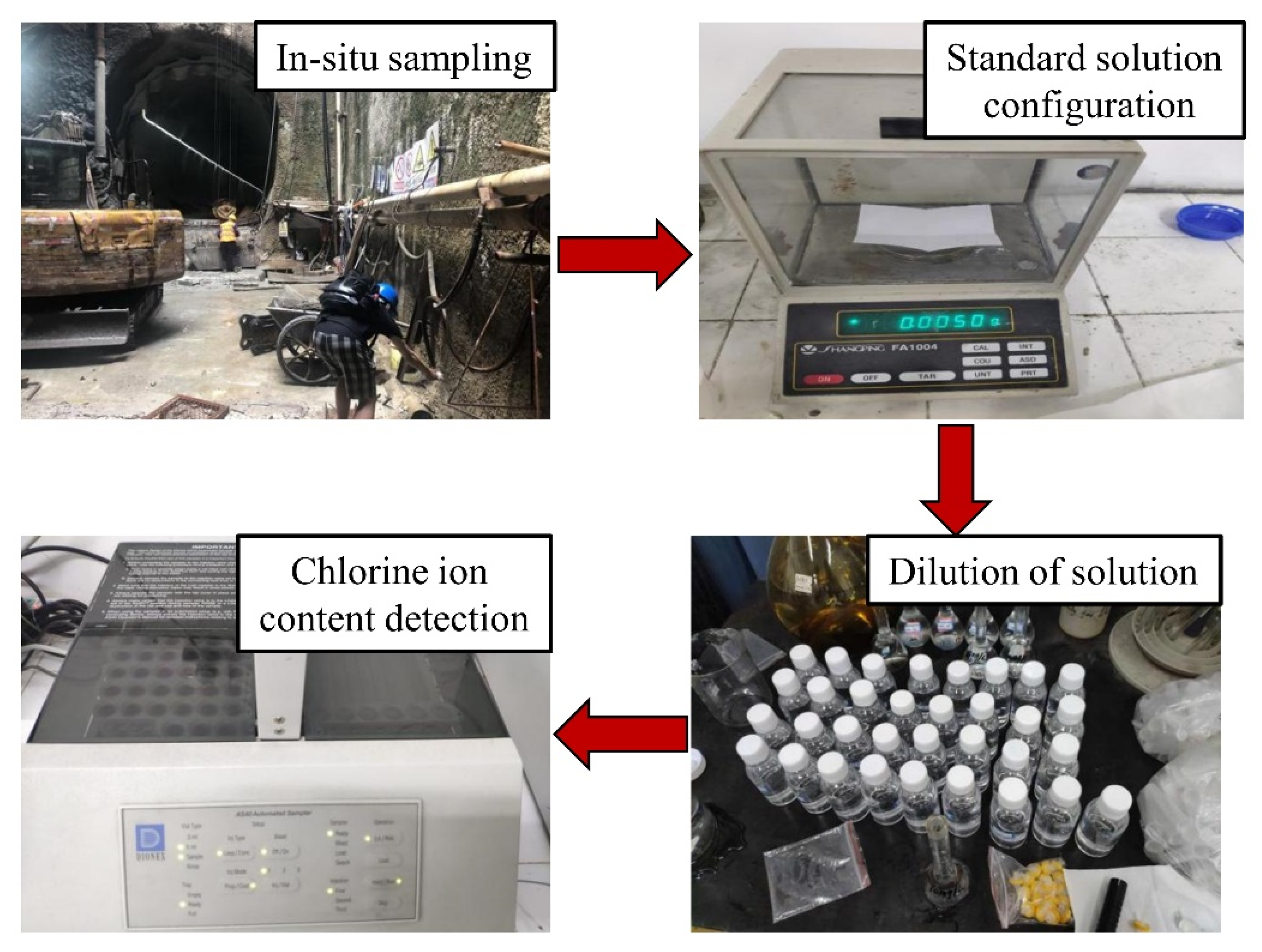
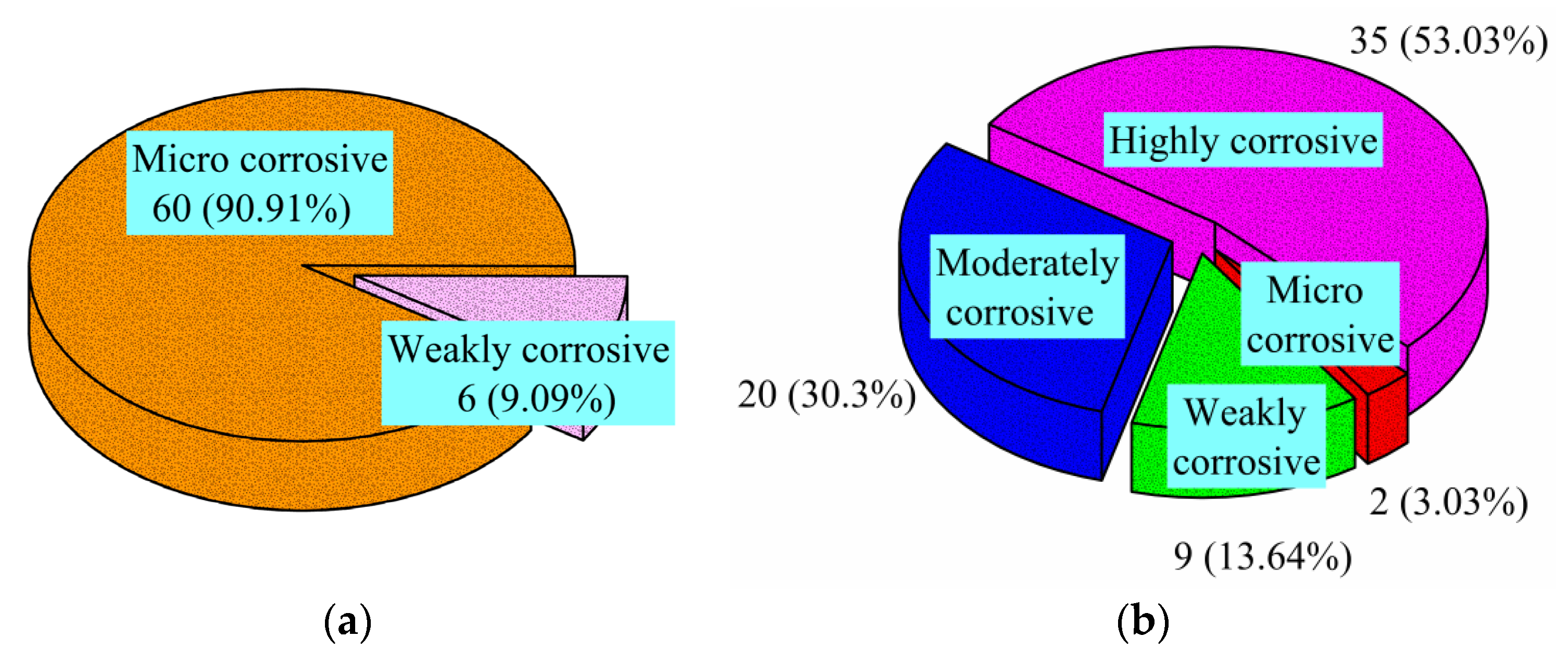
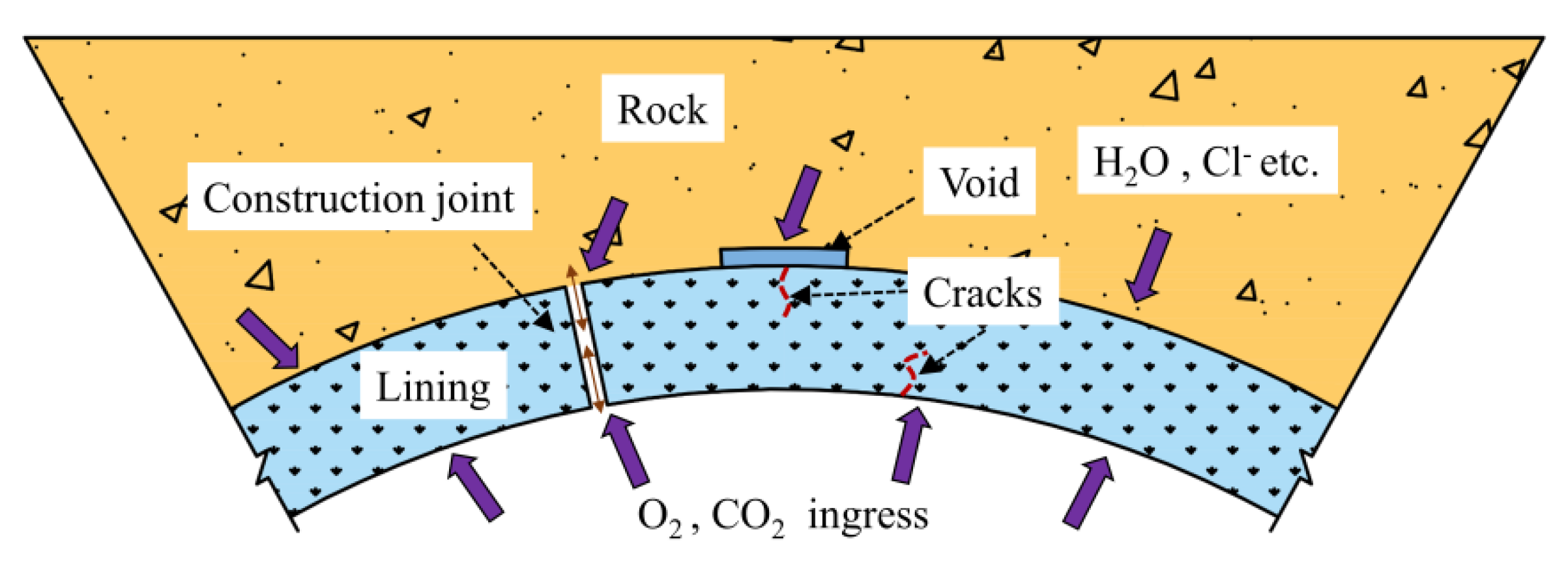
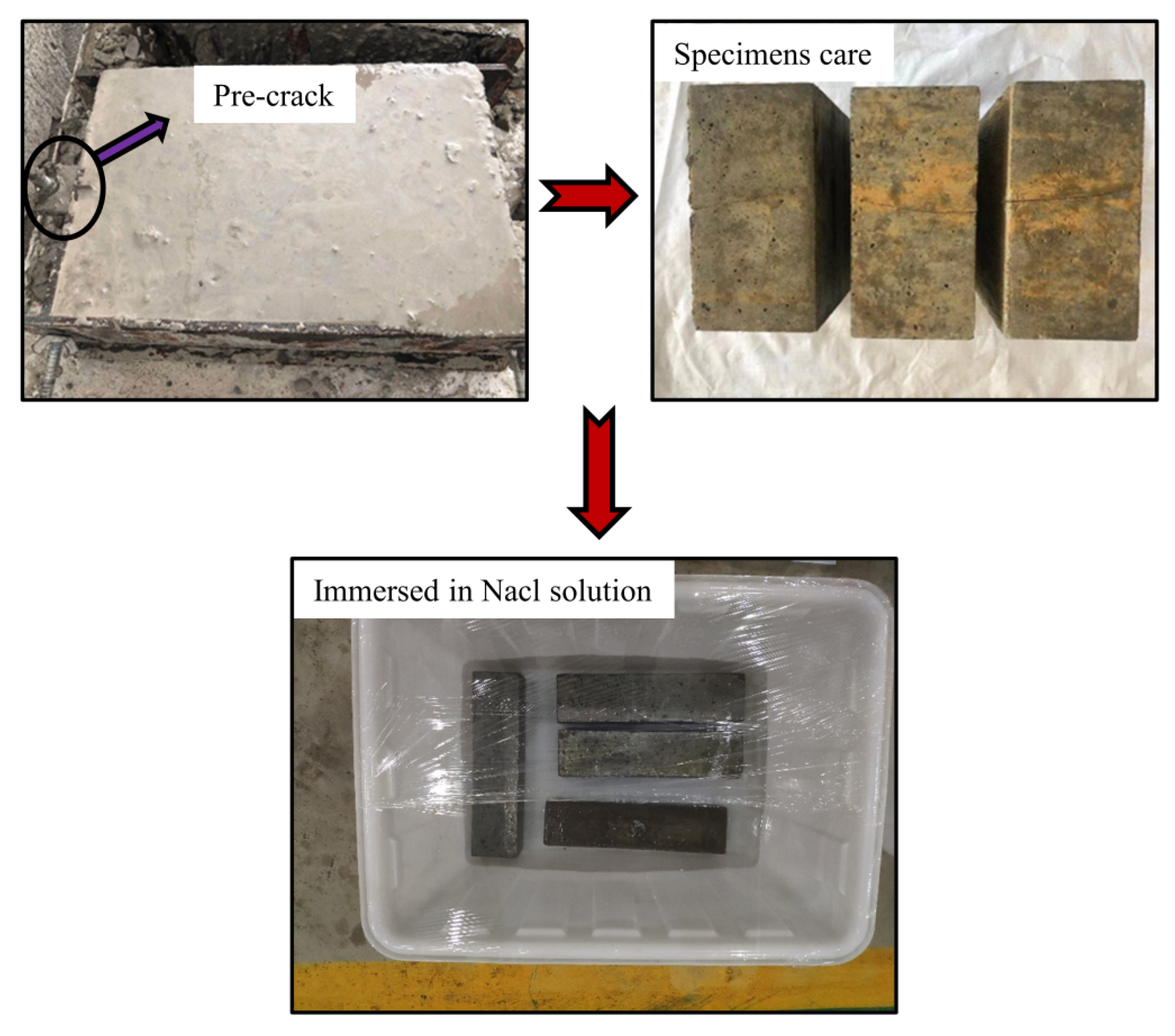
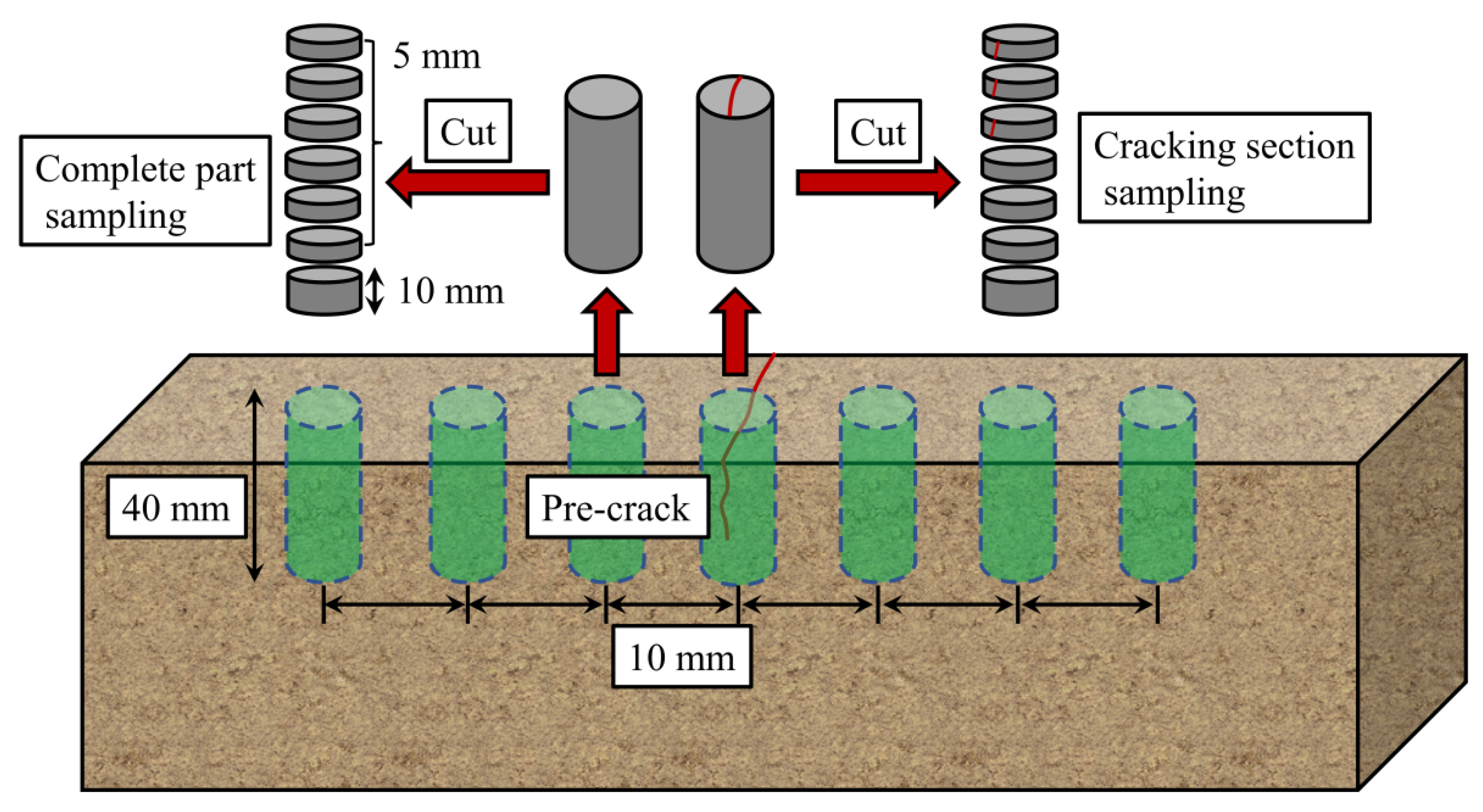
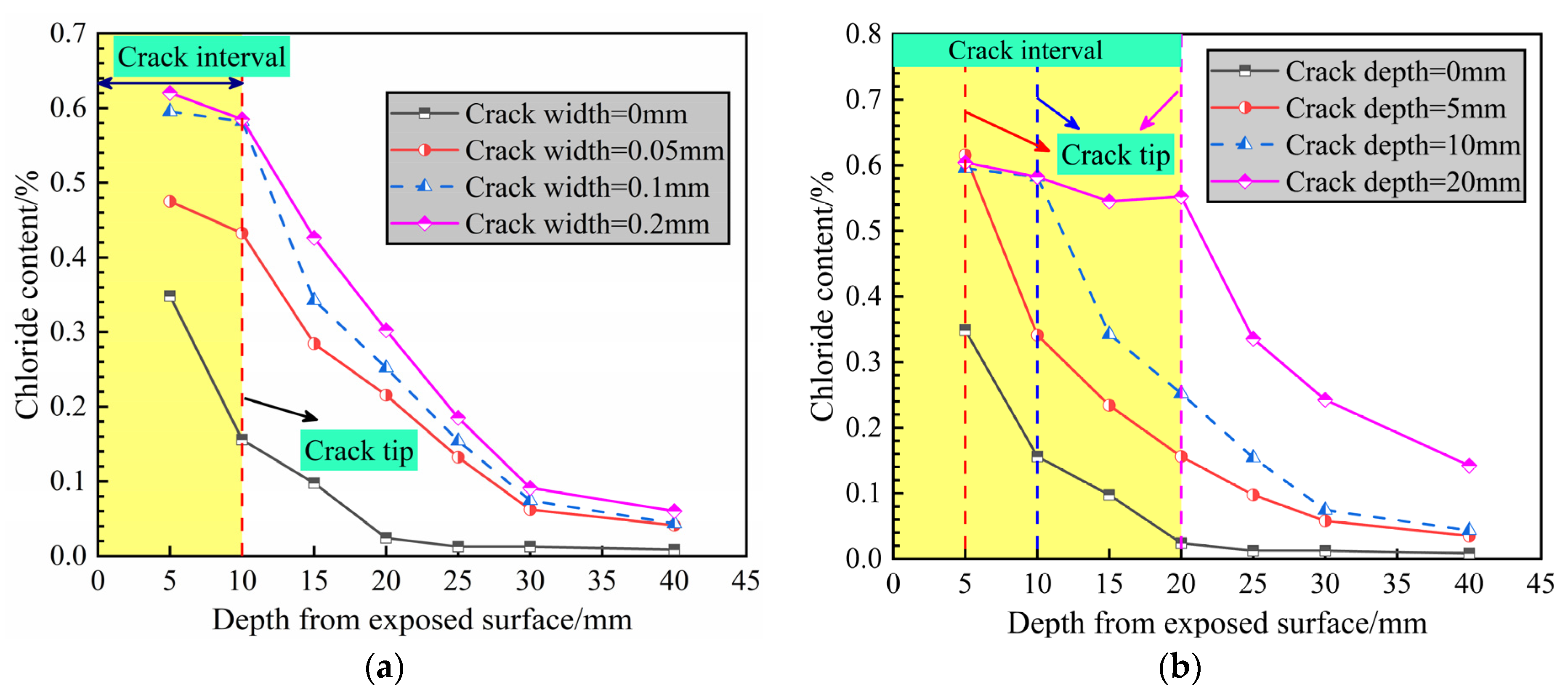
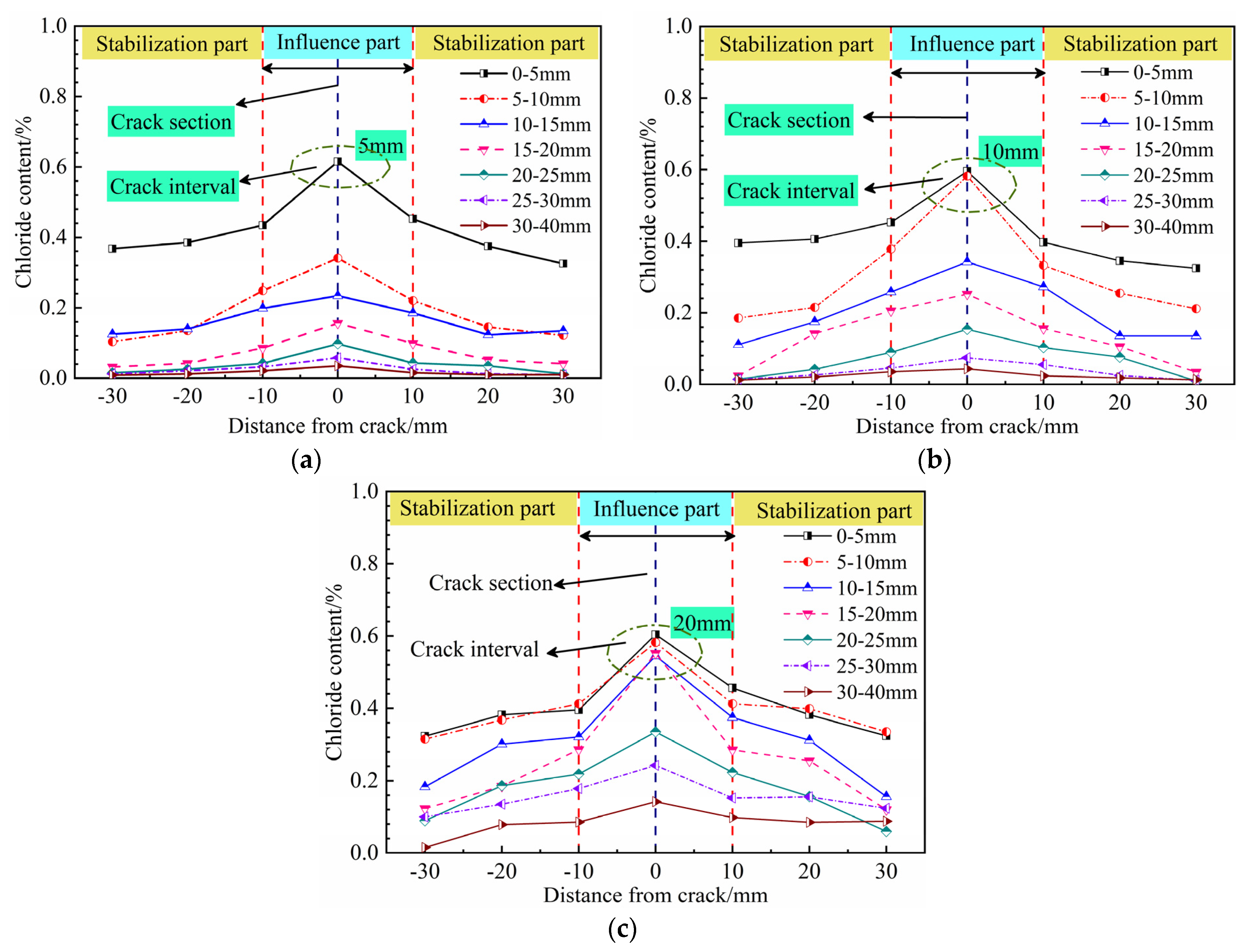
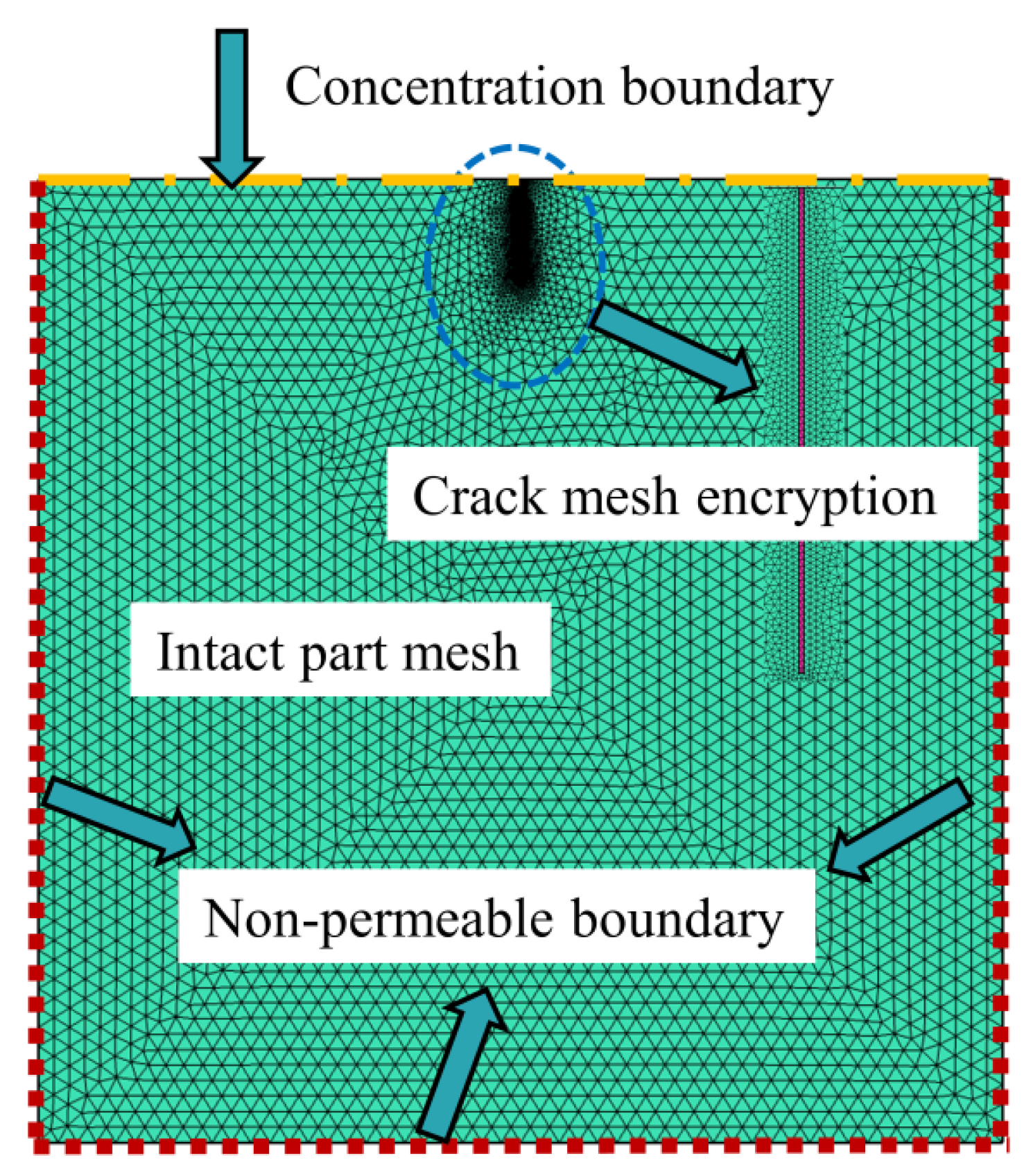
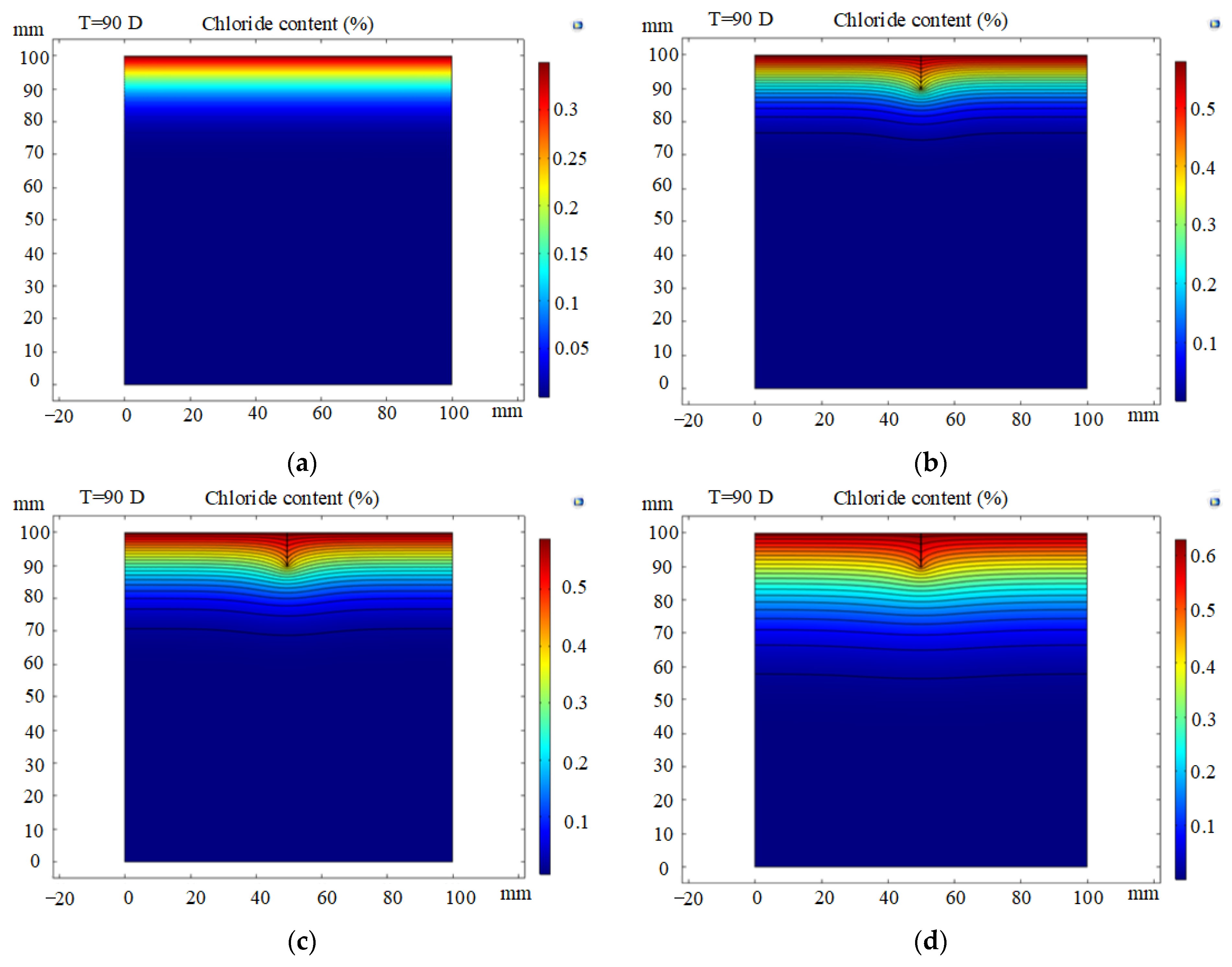
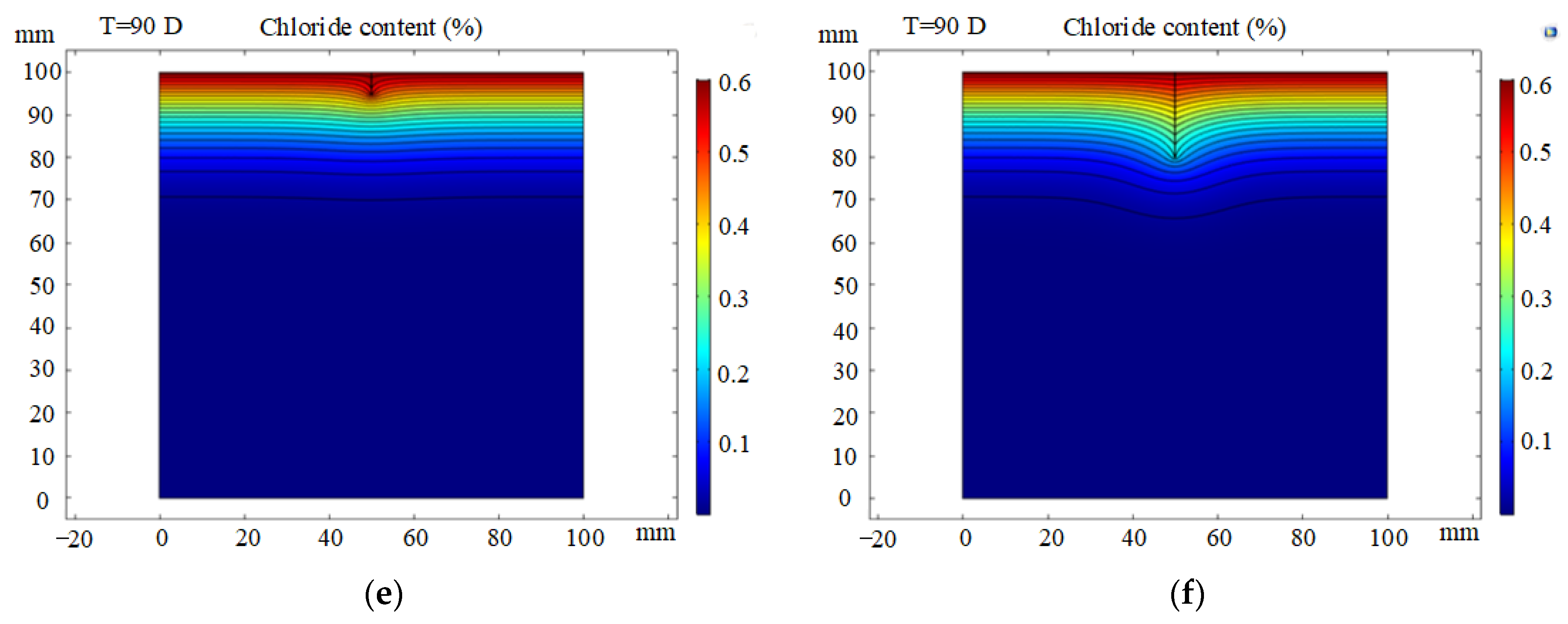
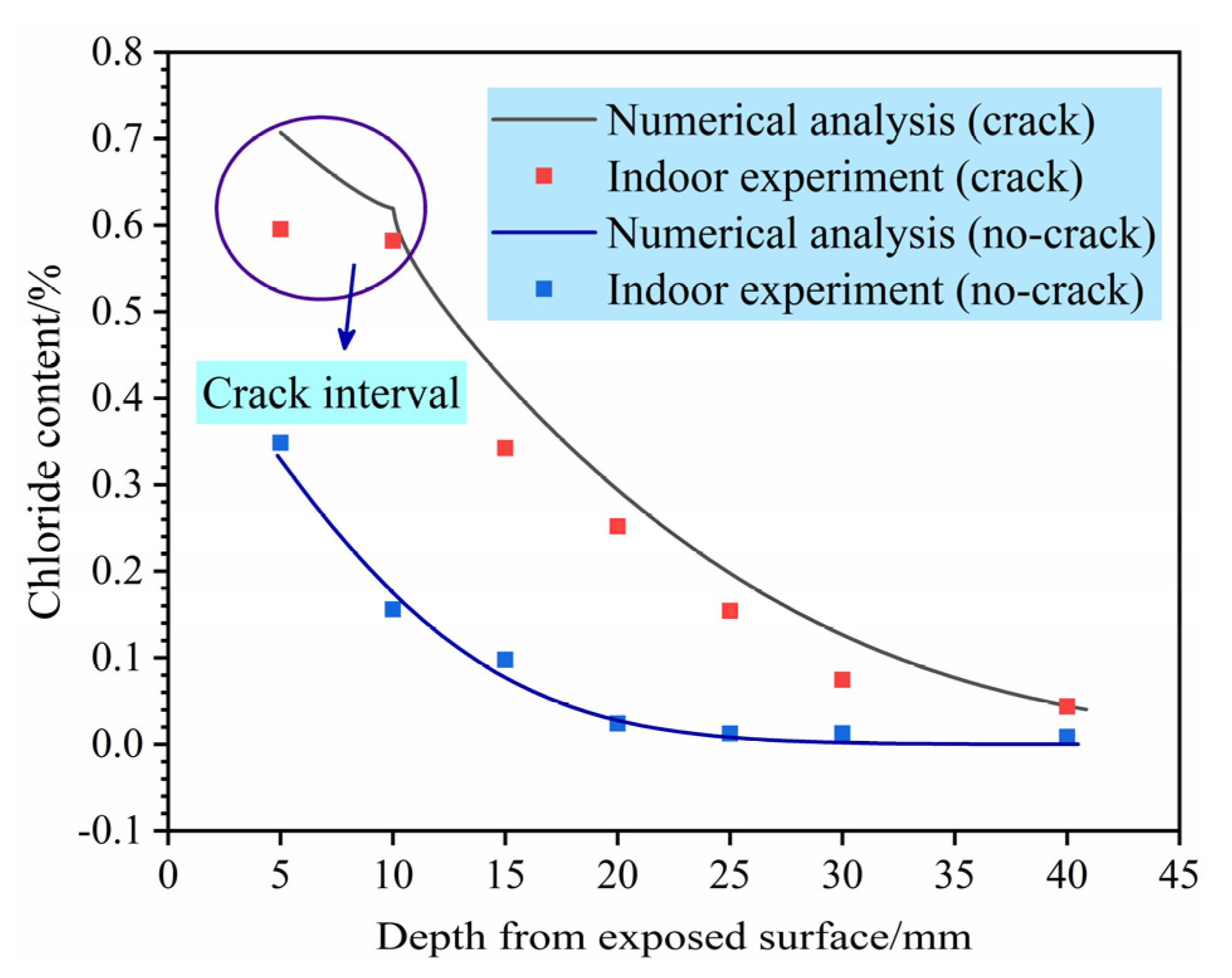
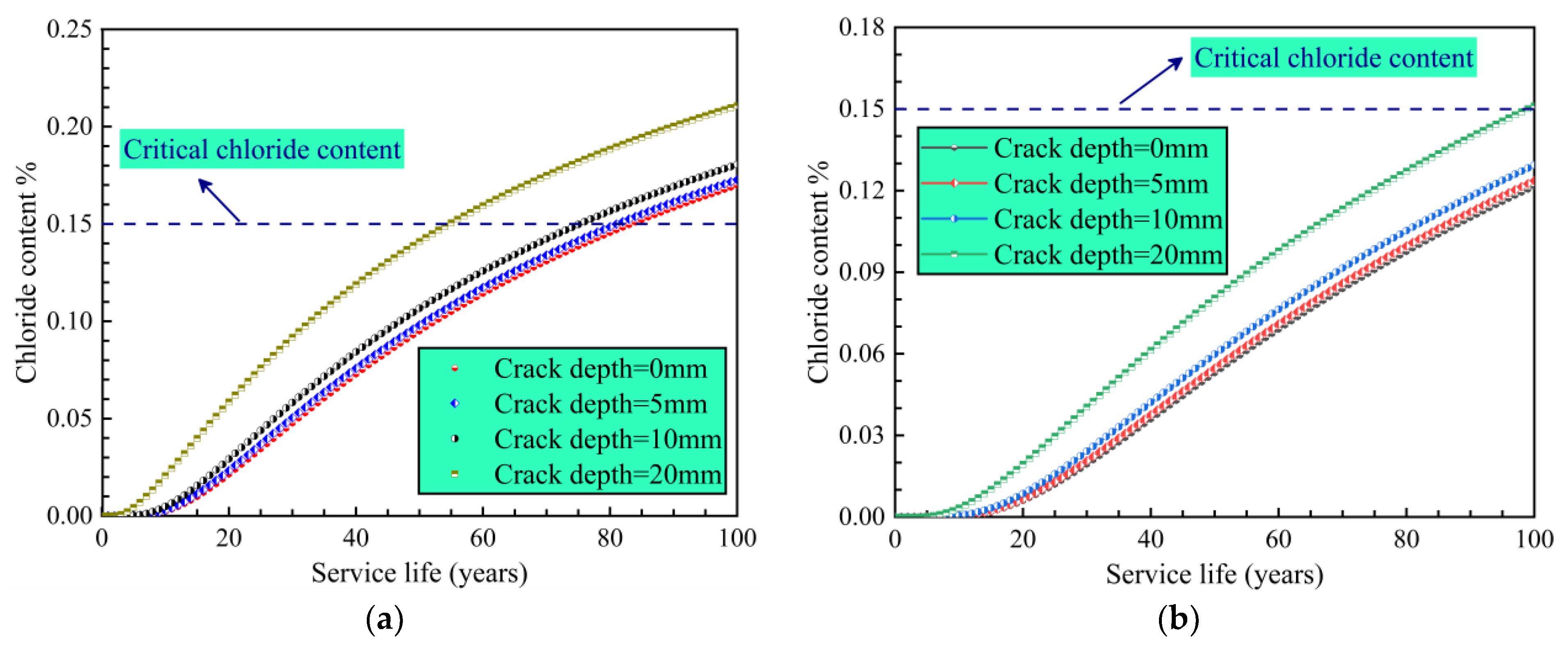
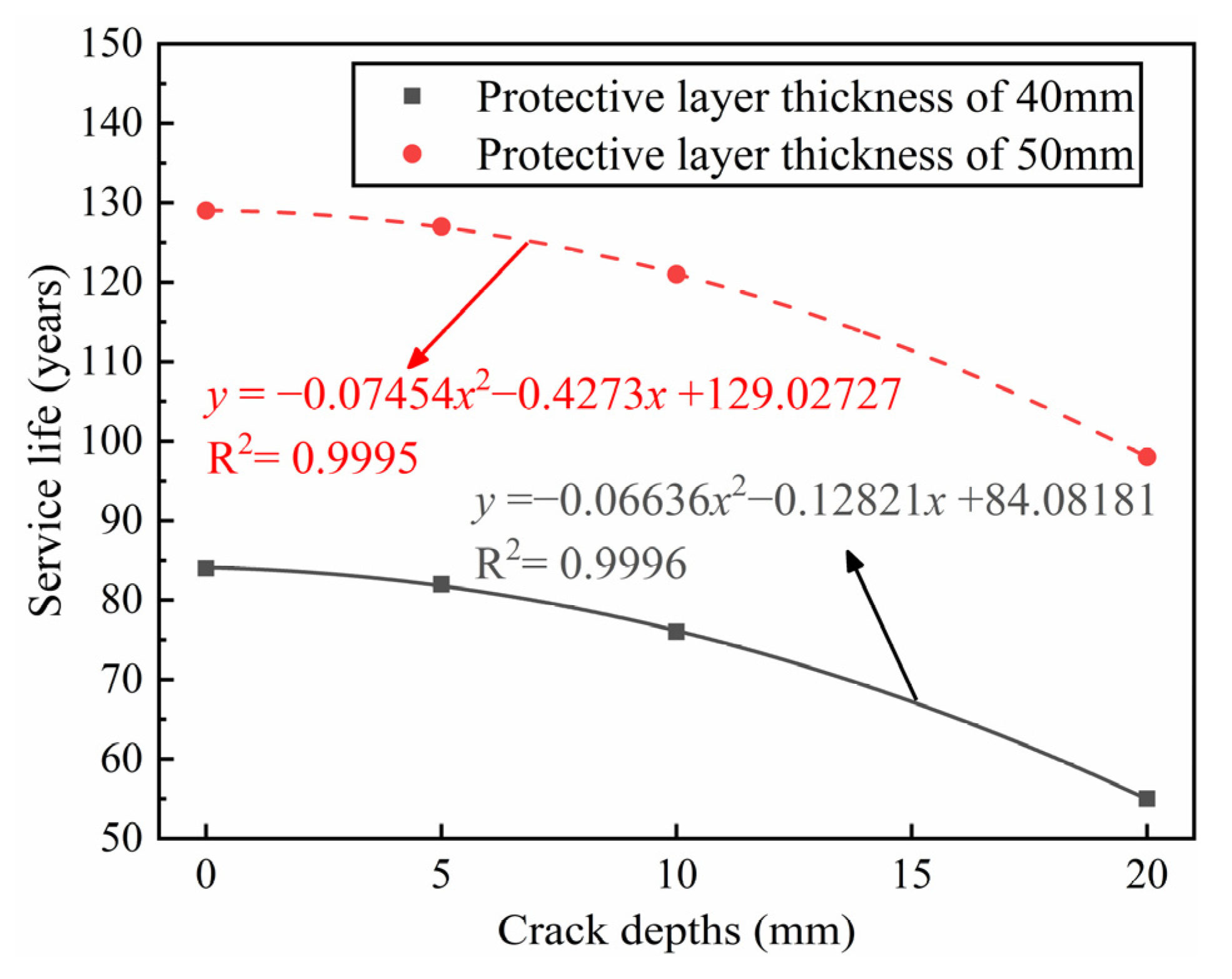
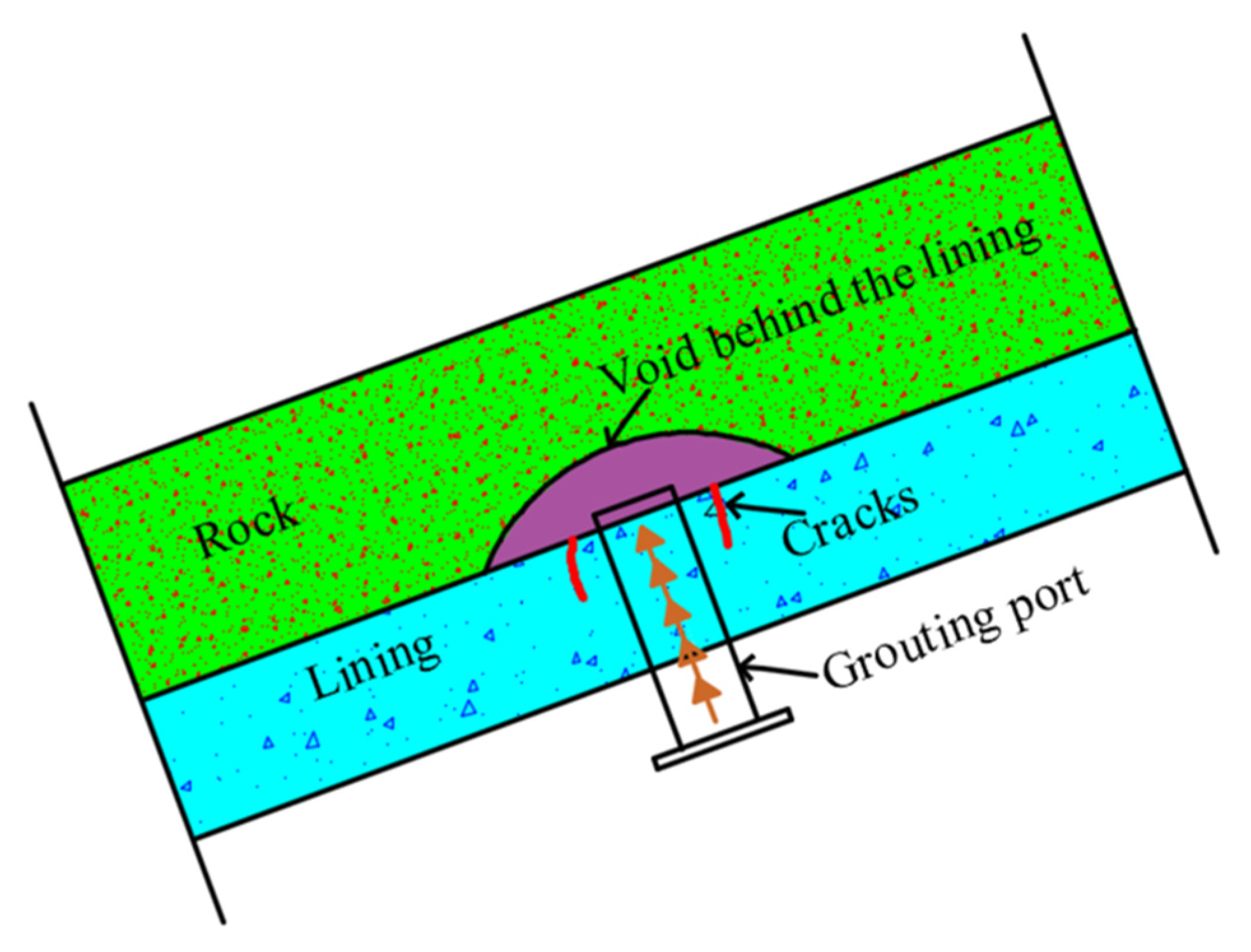

| Corrosion Level | Chloride Ion Concentration in Groundwater (mg/L) | |
|---|---|---|
| Long-Term Immersion | Alternating Wet and Dry Cycles | |
| Micro-corrosion | <10,000 | <100 |
| Weak corrosion | 10,000–20,000 | 100–500 |
| Moderate corrosion | - | 500–5000 |
| High corrosion | - | >5000 |
| NO. | Cement | w/b | Fine Aggregate | Coarse Aggregate | Water | S.P. | F.A. | S.L. |
|---|---|---|---|---|---|---|---|---|
| C45 | 360 | 0.35 | 750 | 1035 | 158 | 6.3 | 40 | 50 |
| Table. | Crack Width (mm) | Crack Depth (mm) |
|---|---|---|
| 1 | 0 | 0 |
| 2 | 0.05 | 10 |
| 3 | 0.1 | 10 |
| 4 | 0.2 | 10 |
| 5 | 0.1 | 5 |
| 6 | 0.1 | 20 |
| Crack Depth (mm). | Crack Width (mm) | D(w) (×10−12 m2/s) | f(w) | R2 |
|---|---|---|---|---|
| 0 | 0 | 6.0018 | 1 | 0.9905 |
| 5 | 0.1 | 10.8619 | 1.81 | 0.9861 |
| 10 | 0.05 | 16.3474 | 2.72 | 0.9772 |
| 10 | 0.1 | 20.1550 | 3.36 | 0.9896 |
| 10 | 0.2 | 23.2607 | 3.88 | 0.9679 |
| 20 | 0.1 | 28.0135 | 4.67 | 0.9764 |
Publisher’s Note: MDPI stays neutral with regard to jurisdictional claims in published maps and institutional affiliations. |
© 2021 by the authors. Licensee MDPI, Basel, Switzerland. This article is an open access article distributed under the terms and conditions of the Creative Commons Attribution (CC BY) license (https://creativecommons.org/licenses/by/4.0/).
Share and Cite
Zhang, S.; Xu, Q.; Ren, R.; Sui, J.; Liu, C.; Yuan, C. Chloride Transport Behaviour and Service Performance of Cracked Concrete Linings in Coastal Subway Tunnels. Materials 2021, 14, 6663. https://doi.org/10.3390/ma14216663
Zhang S, Xu Q, Ren R, Sui J, Liu C, Yuan C. Chloride Transport Behaviour and Service Performance of Cracked Concrete Linings in Coastal Subway Tunnels. Materials. 2021; 14(21):6663. https://doi.org/10.3390/ma14216663
Chicago/Turabian StyleZhang, Sulei, Qing Xu, Rui Ren, Jiahao Sui, Chang Liu, and Changfeng Yuan. 2021. "Chloride Transport Behaviour and Service Performance of Cracked Concrete Linings in Coastal Subway Tunnels" Materials 14, no. 21: 6663. https://doi.org/10.3390/ma14216663
APA StyleZhang, S., Xu, Q., Ren, R., Sui, J., Liu, C., & Yuan, C. (2021). Chloride Transport Behaviour and Service Performance of Cracked Concrete Linings in Coastal Subway Tunnels. Materials, 14(21), 6663. https://doi.org/10.3390/ma14216663






